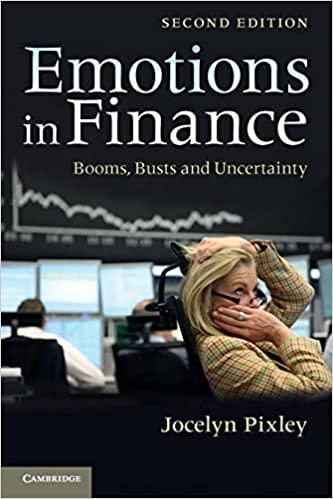Question
As a risk manager, your task is to evaluate the downside risk of a given asset. In particular, you need to compute the Value at
As a risk manager, your task is to evaluate the downside risk of a given asset. In particular, you need to compute the Value at Risk (VaR) for the SPY ETF based on the period dating between Jan 2017 and Dec 2021. To do so, you need to perform the following tasks:
(a) To get started, you need to work with weekly adjusted closing prices. The total time series should correspond to 261 weeks. Based on this data, calibrate the and , assuming that the asset price follows a geometric Brownian motion. Report the estimates in a table.
(b) Given the calibrated parameters. Assume that the initial price is given by the last closing price from the week of Jan 8th, 2017. This price should be around $200s. Based on this information and Monte Carlo (MC), you need to simulate the asset price path 1000 times over 260 weeks, corresponding to five years of data. To ensure your results are correct, compute the simulated conditional expectation and variance of S5 given S0 and compare them to the true values. You should report all four values in a single table.
(c) In reality, there was a single trajectory of how the SPY price played out during this sample period. On the other hand, the MC simulation results in 1000 paths. Clearly, out of the 1000 paths, there is one simulation that deviates the most and one that deviates least from the true trajectory. Can you spot the latter? As a summary, plot this simulated path versus the actual one.
Hint: There is a zero chance that a simulated path will be exactly the same as the true one. However, one can measure the distance between the simulated path and the true one over time. One potential candidate to measure such distance is the second norm of the differential between the two paths. This is similar to the sum of squared errors. The goal is to identify the path with the lowest discrepancy with the actual data.
(d) Suppose you purchased 100 SPY ETFs on Jan 8th, 2017. Based on the simulated paths, compute the 99% VaR of this portfolio position at the end of 2021. (10 Points) (e) Clearly, the above computed VaR depends on the calibrated and . Instead of computing the VaR based on the calibrated , consider a sequence of values for {0.10,0.11,...,0.49,0.50}, while keeping constant and equal to the calibrated value from
Part (a). For each value, you need to rerun the 1000 simulations and compute the 99% VaR from the last part as a function of . As a summary, address the following i. Plot the 99% VaR as a function of .
ii. What does the last part tells us in terms of model risk, i.e., the importance of getting the suitable model or calibrated parameters? iii. How do you justify the shape of the function from Part (e)? Is it linear or nonlinear? For instance, how does it compare with the case of an IID Gaussian process? f) Instead of computing the 99% VaR of the portfolio position at the end of 2021, you are inter- ested in computing the weekly 99% VaR of the weekly portfolio return using two approaches: i. Historical: In this case, assume that the 260 weekly returns represent the return on the portfolio position. Based on these realized returns, compute the 99% VaR? Note: In this case, the 99% VaR corresponds to the average historical returns minus the 99% historical percentile. ii. Parametric: This approach relies on the MC simulated paths from Part (b). Given the simulated paths, you can compute the weekly log-returns. This will result in a large simulated sample of 1000 260. Based on this large data, compute the 99% VaR as you did in the previous part (historical approach). iii. How do both risk metrics compare? iv. As a final perspective, plot the density of the historical returns versus the simulated returns. What do you observe?v. What did you learn from this exercise in terms of model risk?
Step by Step Solution
There are 3 Steps involved in it
Step: 1

Get Instant Access to Expert-Tailored Solutions
See step-by-step solutions with expert insights and AI powered tools for academic success
Step: 2

Step: 3

Ace Your Homework with AI
Get the answers you need in no time with our AI-driven, step-by-step assistance
Get Started


